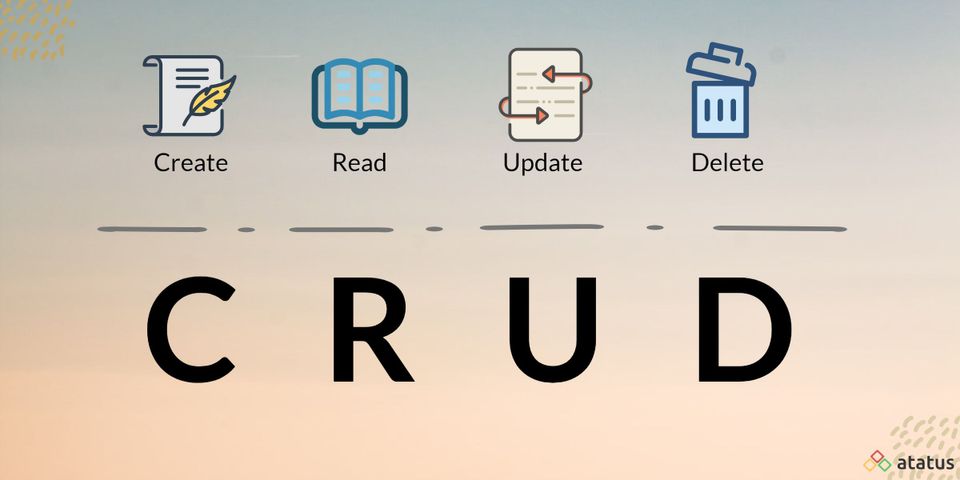You've probably worked with CRUD operations if you've ever worked with a database. SQL frequently uses CRUD procedures. Since SQL is so commonly used in the technology industry, developers must understand how CRUD operations operate.
Here, how it’s done:
What is CRUD?
The abbreviation CRUD stands for create, read, update, and delete in computer programming. The four basic roles of persistent storage are as follows. In addition, each letter of the acronym can refer to any function in a relational database application that is mapped to a typical HTTP method, SQL statement, or DDS action.
It can also refer to user-interface conventions that let users browse, search, and alter data using computer-based forms and reports. Entities are read, created, updated, and deleted in this way. Those same entities can be changed by collecting data from a service and updating setting properties before returning the data to the service for an update. Furthermore, CRUD is data-driven, and HTTP action verbs are standardized.
CRUD capability is present in almost all applications. CRUD is something that every coder has had to deal with at some point. A CRUD application, by the way, is one that uses forms to retrieve and return data from a database.
CRUD Operations
Tables with rows and columns make up a relational database. Each row of a table is referred to as a tuple or a record in a relational database. Each table column represents a distinct property or field. Users can utilize the four CRUD methods to execute various types of operations on specified data in the database. This could be done with code or with the help of a graphical user interface.
Let's take a closer look at each of the four components to see how important they are when it comes to facilitating database interactions.
Create
Users can use the create function to add a new record to the database. The Create function in a SQL relational database application is called INSERT. It's known as create in Oracle HCM Cloud. Remember that a row is referred to as a record and that columns are referred to as attributes.
A user can add new attributes to the table by creating a new row and filling it with data that corresponds to each property. However, only an administrator may be able to add new attributes to the database itself.
Read
The read command is analogous to the search command. It allows users to search for and read the values of individual records in the table. Users may be able to find required records by searching for them using keywords or filtering the data using specific criteria.
A database of vehicles, for example, would allow users to search for "2005 Maruti Swift" or provide choices to filter search results by make, model, and year.
Update
The update function is used to make changes to the database's existing records. Users may need to edit information in numerous fields to completely change a record.
A restaurant, for example, might have a table with the attributes "dish," "cooking time," "cost," and "pricing" that contains recipes for menu items in a database. The owner decides to replace one of the dishes with something new and changes the timing one day. As a result, the old database record must be updated, with all attribute values updated to reflect the new dish's features. The update function is simply called "Update" in both SQL and Oracle HCM cloud.
Delete
Users can utilize the delete function to delete records from a database that is no longer needed. The delete function is available in both SQL and Oracle HCM Cloud, allowing users to remove one or more records from the database.
Users may be able to do a hard delete or a soft delete in some relational database applications. A hard delete removes records from the database permanently, but a soft delete updates the status of a row to show that it has been destroyed while leaving the contents intact.
How does CRUD Work?
Depending on the system's requirements, various users may have different CRUD cycles. Customers can utilize CRUD to create accounts and access those accounts when they return to a site. The user can then make changes to his or her personal information or billing details. An operations manager, on the other hand, might build product records and then call them as needed or change line items.
CRUD processes were at the heart of most dynamic websites during the Web 2.0 era. You should, however, distinguish CRUD from HTTP action verbs. If you wish to create a new record, for example, you should use “POST.” You would use “PUT” or “PATCH” to update a record. The command “Erase” would be used to delete a record. Users and administrators have the ability to edit, delete, create, and browse online records using CRUD.
When it comes to performing CRUD activities, an application designer has a lot of possibilities. To conduct processes, one of the most efficient options is to establish a collection of stored procedures in SQL. The following are some popular naming conventions for CRUD stored procedures:
- The procedure name should conclude with the CRUD operation's implementation name. The prefix for user-defined stored procedures should not be the same as the prefix for other user-defined stored procedures.
- If you put the table name after the prefix, CRUD methods for the same table will be grouped together.
- After you've added CRUD procedures, you can edit the database schema by determining which database entity will be used for CRUD activities.
Benefits of CRUD
Many programmers prefer CRUD to ad-hoc SQL statements because of its speed. The execution plan for a stored procedure is saved in SQL Server's procedure cache and reused for all subsequent calls to the procedure.
When SQL Server executes a SQL statement, the relational engine checks the procedure cache to determine if an existing execution plan for that SQL statement exists, and if so, it uses that plan to reduce the need for SQL statement optimization, parsing, and recompiling.
If an execution plan isn't found, SQL Server will generate a new execution plan for the query. Furthermore, when SQL statements are removed from application code, all SQL can be stored in the database, leaving only stored procedure calls in the client application. Using stored procedures can help to reduce database coupling.
Additionally, performing CRUD operations protects against SQL injection attacks. Since all SQL Statements employ stored procedures instead of string concatenation to generate dynamic queries from user input data, everything entered into a parameter is quoted.
Why CRUD is Important?
CRUD is frequently used in database and database design cases. Without CRUD operations, software developers can't get anything done. REST, a superset of CRUD for HTTP resources, is used in website building, for example.
End-users, on the other hand, rely heavily on CRUD. It would be hard to register for websites, create blogs, or bookmarks without it. We can add or create new entries, search for and update existing ones, and delete them in most of the applications we use.
CRUD has a number of advantages, including:
- It simplifies security control by meeting a variety of access criteria
- It makes application design easier and more scalable by simplifying and facilitating it
- When compared to ad-hoc SQL statements, it performs better
Summary
The four major functions implemented in database applications are create, retrieve, update, and delete (CRUD). Users can create, view, modify, and alter data using the CRUD functions, which are database user interfaces. CRUD is a database manipulation tool that works with entities. CRUD restrictions are enforced by any simple database table.
Monitor Your Entire Application with Atatus
Atatus provides a set of performance measurement tools to monitor and improve the performance of your frontend, backends, logs and infrastructure applications in real-time. Our platform can capture millions of performance data points from your applications, allowing you to quickly resolve issues and ensure digital customer experiences.

Atatus can be beneficial to your business, which provides a comprehensive view of your application, including how it works, where performance bottlenecks exist, which users are most impacted, and which errors break your code for your frontend, backend, and infrastructure.





